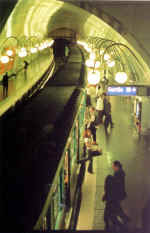Paris is the innovator on using rubber tires on metro routes. The
advantages to rubber tires are quicker acceleration and faster braking. That is
why they were employed on routes 1&4 the two busiest lines on the system.
Line 11 (lightly traveled line) was the first line converted to rubber
tires as a test. Route 6 was the last
line converted due to the costs. The trackways still maintain the
standard gauge track. The rails are used to guide trains through a interlocking, as well as to provide emergency support in the event that a
tire goes flat. The tires create a lot of heat due to friction and are
not that much quieter underground than the steel wheeled lines.
Note: Line 14 is rubber tired but is covered under the
automated metro page.
Click on any image to enlarge.
 A
Line 1 train at Gare de Lyon Station. A busy station on the line. A
Line 1 train at Gare de Lyon Station. A busy station on the line. |
 Newer
MP89 stock at Charles de Gaulle Station Line 1. Newer
MP89 stock at Charles de Gaulle Station Line 1. |
 A
Line 6 train at Duplex Station, this is an elevated station. (11/99) A
Line 6 train at Duplex Station, this is an elevated station. (11/99) |
 Old
meets new on Line one at the Tuileries Station. (2/00 video.) Old
meets new on Line one at the Tuileries Station. (2/00 video.) |
 Trains
pass each other crossing the Seine River, note the Arc de Triomphe in
the background. (2/00 video.) Trains
pass each other crossing the Seine River, note the Arc de Triomphe in
the background. (2/00 video.) |
 Older
stock with new front on Line 1 crossing the Seine River. (2/00 video.) Older
stock with new front on Line 1 crossing the Seine River. (2/00 video.) |
 The
two red eyes shows this line 1 train leaving the La Defense Terminal.
(2/00) The
two red eyes shows this line 1 train leaving the La Defense Terminal.
(2/00) |
 Line
1 train departing... (2/00) Line
1 train departing... (2/00) |
 This
the beautiful La Cite station. It is very deep underground as the
line is going under the Seine. (NK 07/04) This
the beautiful La Cite station. It is very deep underground as the
line is going under the Seine. (NK 07/04) |
 La
Cite stop is under the original center part of Paris, an island in the
middle of the river. (nk 7/04) La
Cite stop is under the original center part of Paris, an island in the
middle of the river. (nk 7/04) |
 Passengers
entering/leaving the train at La Cite. Notre Dame is a short walk from
this station. (NK 7/04) Passengers
entering/leaving the train at La Cite. Notre Dame is a short walk from
this station. (NK 7/04) |
|